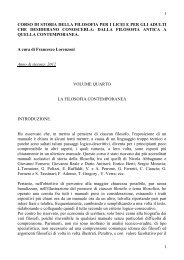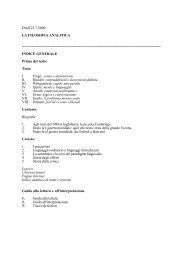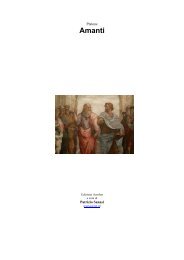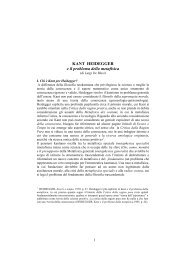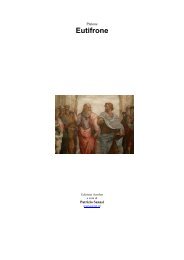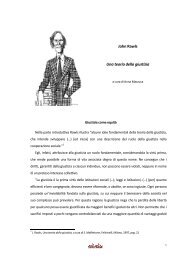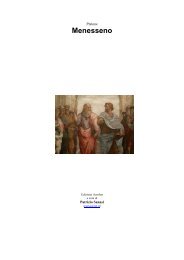Ragione e pratica sociale: l'inferenzialismo di Robert Brandom 1
Ragione e pratica sociale: l'inferenzialismo di Robert Brandom 1
Ragione e pratica sociale: l'inferenzialismo di Robert Brandom 1
- No tags were found...
You also want an ePaper? Increase the reach of your titles
YUMPU automatically turns print PDFs into web optimized ePapers that Google loves.
development of themes of the main book. We give here some hint on the contrast between AlvinGoldman and <strong>Brandom</strong> on the results of the criticism of the causal theories of knowledge. Thealternative to <strong>di</strong>rect reference theory is <strong>di</strong>scussed with an example on Kripke’s <strong>di</strong>stinctionbetween speaker’s reference and semantic reference. Even this <strong>di</strong>stinction can be placed in aframework where the anaphora is the lea<strong>di</strong>ng concept which helps to explain the working of ourlanguage in communication. Eventually, some internal <strong>di</strong>fficulties of <strong>Brandom</strong>'s project arehinted at, even if they do not deprive the general framework of its interest.N1 Ringrazio <strong>Robert</strong> <strong>Brandom</strong> per il tempo che mi ha de<strong>di</strong>cato nel <strong>di</strong>scutere il suo lavoro el'anonimo referee della “Rivista <strong>di</strong> Filosofia” per gli utili suggerimenti.2 In via <strong>di</strong> pubblicazione presso la Harvard University Press con il titolo Articulating Reason. Illibro maggiore, Making it Explicit, Representing Discourse and Discoursive Commitment, èstato anch’esso pubblicato dalla Harvard U.P., nel 1994. L'articolo <strong>di</strong> Leonar<strong>di</strong> La semantica <strong>di</strong>ISA, in "Lingua e stile", XXXII, 1997 (pp. 539-55) e il <strong>di</strong>battito sul n.26 <strong>di</strong> “Iride”, XII, 1999sono, a quanto so, le sole riflessioni su <strong>Brandom</strong> apparse in italiano.3 L'idea viene da un articolo <strong>di</strong> uno dei più importanti logici e filosofi contemporanei, DavidLewis Scorekeeping in a Language Game in “Journal of Philosophical Logic”, VIII, 1979,pp.339-359.4 M. Dummett, Can Analytic Philosophy be Systematic and Ought it to be? in Truth and otherEnigmas, Duckworth 1978, tr.it. <strong>di</strong> M.Santambrogio, La verità e altri enigmi, Milano , IlSaggiatore, 1986.5 Ve<strong>di</strong> ad es. N. Rescher, The Strive of Systems, an Essay on the Grounds and Implications ofPhilosophical Diversity, Pittsburgh, University of Pittsburgh Press, 1985; trad.it. <strong>di</strong> N. Vassallo,a cura <strong>di</strong> A. Bottani, La lotta dei sistemi, Genova , Marietti, 1994.6 W. Sellars, Language Rules and Behaviour, in Pure Pragmatics and Possibe Worlds: TheEarly Essays of Wilfrid Sellars (a cura <strong>di</strong> J. Sicha), Reseda (CA), Ridgeview Publishing, 1979,p.236, nota 2.7 In inglese committments e entitlements; ho tradotto entitlements con “<strong>di</strong>ritti” per semplicità <strong>di</strong>traduzione e perché non interferisce con altri aspetti della <strong>di</strong>scussione sulle norme svolta nelpresente lavoro. È però da ricordare che to be entitled vuol <strong>di</strong>re letteralmente “avere i titoli per”;aver i titoli per asserire un enunciato comporta avere un giustificazione, quin<strong>di</strong> avere l'autorità o il<strong>di</strong>ritto <strong>di</strong> asserirlo.8 Ogni semantica del ruolo inferenziale si scontra con il problema dei contenuti empirici; unarisposta a questo problema viene data dal modello generale sviluppato sulla scia delle idee <strong>di</strong>Dummett. Il modello generale consiste nel trattare il contenuto <strong>di</strong> una espressione linguisticacome l'insieme delle circostanze e delle conseguenze della sua applicazione. Nel caso dei concettiempirici, tra le circostanze in cui l'espressione è correttamente applicata dovremmo includere nonsolo le possibili premesse inferenziali, ma anche le circostanze percettive noninferenziali. Questarisposta permette <strong>di</strong> rispondere ai <strong>di</strong>lemmi <strong>di</strong> Putnam sul significato <strong>di</strong> "acqua" sulla terra e sullaterra gemella; se il significato è inteso come l'insieme delle circostanze e delle conseguenzedell'applicazione corretta <strong>di</strong> un termine, allora "acqua" sulla terra e sulla terra gemella avranno<strong>di</strong>verso significato perché, se pure ogni espressione contenente il termine "acqua" potrà avere lestesse conseguenze, il termine "acqua" è correttamente applicato in due circostanze percettive<strong>di</strong>fferenti quella in cui "acqua" si riferisce a H2O e quelle in cui "acqua" si riferisce a XYZ.9 Qui <strong>Brandom</strong> fa riferimento alla generalizzazione delle definizioni dei connettivi logici <strong>di</strong>Gentzen elaborata da Dummett.10 Ve<strong>di</strong> E.L. Gettier Is Justified True Belief Knowledge? in “Analysis” XXIII, 1963, pp. 121-123, tr. it. in Significato e teorie del linguaggio (a cura <strong>di</strong> A. Bottani-C. Penco) Milano, Angeli,1991. Per una rassegna delle nuove teorie della conoscenza ve<strong>di</strong> i saggi contenuti inIntroduzione al naturalismo filosofico contemporaneo (a cura <strong>di</strong> E. Agazzi-N.Vassallo)Milano, Angeli, 1998.




